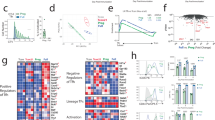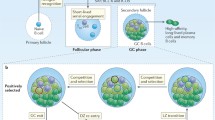Abstract
T follicular helper (Tfh) cells provide essential help to B cells for the generation of high-affinity antibodies. These mechanisms provide the basis for the success of modern vaccines, but dysregulated Tfh cell responses are also linked to autoimmune diseases. In addition to their established role in driving humoral immunity, Tfh cells are gaining attention for their role in other processes of the adaptive immune system. For example, Tfh cells may serve as transitional differentiation intermediates during effector and memory T-helper cell differentiation and as a reservoir of HIV-infected cells. While B cells are required for the full maturation and maintenance of Tfh cell responses, they are dispensable for the initial induction of the Tfh cell phenotype, which occurs at the priming stage through interaction with dendritic cells. Nevertheless, the precise mechanisms of these early events during Tfh cell differentiation remain relatively unknown. Here, we describe a method for tracking early Tfh cell differentiation by following cell division kinetics and phenotypic changes of recently activated antigen-specific CD4+ T cells in vivo. As an example, we use this method to visualize the requirements for T cell-expressed CD28 for the differentiation of CXCR5+Bcl6+ Tfh cells.
Access this chapter
Tax calculation will be finalised at checkout
Purchases are for personal use only
Similar content being viewed by others
References
Ma CS, Deenick EK, Batten M et al (2012) The origins, function, and regulation of T follicular helper cells. J Exp Med 209:1241–1253
Qi H, Liu D, Ma W et al (2014) Bcl-6 controlled T polarization and memory: the known unknowns. Curr Opin Immunol 28C:34–41
Crotty S (2011) Follicular helper CD4 T cells (T(FH)). Annu Rev Immunol 29:621–663
Vinuesa CG, Cyster JG (2011) How T cells earn the follicular rite of passage. Immunity 35:671–680
Victora GD, Nussenzweig MC (2012) Germinal centers. Annu Rev Immunol 30:429–457
Baumjohann D, Okada T, Ansel KM (2011) Cutting edge: distinct waves of BCL6 expression during T follicular helper cell development. J Immunol 187:2089–2092
Choi YS, Kageyama R, Eto D et al (2011) ICOS receptor instructs T follicular helper cell versus effector cell differentiation via induction of the transcriptional repressor Bcl6. Immunity 34:932–946
Goenka R, Barnett LG, Silver JS et al (2011) Cutting edge: dendritic cell-restricted antigen presentation initiates the follicular helper T cell program but cannot complete ultimate effector differentiation. J Immunol 187:1091–1095
Kerfoot SM, Yaari G, Patel JR et al (2011) Germinal center B cell and T follicular helper cell development initiates in the interfollicular zone. Immunity 34:947–960
Kitano M, Moriyama S, Ando Y et al (2011) Bcl6 protein expression shapes pre-germinal center B cell dynamics and follicular helper T cell heterogeneity. Immunity 34:961–972
Deenick EK, Chan A, Ma CS et al (2010) Follicular helper T cell differentiation requires continuous antigen presentation that is independent of unique B cell signaling. Immunity 33:241–253
Baumjohann D, Preite S, Reboldi A et al (2013) Persistent antigen and germinal center B cells sustain T follicular helper cell responses and phenotype. Immunity 38:596–605
Lyons AB, Parish CR (1994) Determination of lymphocyte division by flow cytometry. J Immunol Methods 171:131–137
Quah BJ, Parish CR (2012) New and improved methods for measuring lymphocyte proliferation in vitro and in vivo using CFSE-like fluorescent dyes. J Immunol Methods 379:1–14
Baumjohann D, Kageyama R, Clingan JM et al (2013) The microRNA cluster miR-17 approximately 92 promotes TFH cell differentiation and represses subset-inappropriate gene expression. Nat Immunol 14:840–848
Barnden MJ, Allison J, Heath WR et al (1998) Defective TCR expression in transgenic mice constructed using cDNA-based alpha- and beta-chain genes under the control of heterologous regulatory elements. Immunol Cell Biol 76:34–40
Kamala T (2007) Hock immunization: a humane alternative to mouse footpad injections. J Immunol Methods 328:204–214
Oxenius A, Bachmann MF, Zinkernagel RM et al (1998) Virus-specific MHC-class II-restricted TCR-transgenic mice: effects on humoral and cellular immune responses after viral infection. Eur J Immunol 28:390–400
Shahinian A, Pfeffer K, Lee KP et al (1993) Differential T cell costimulatory requirements in CD28-deficient mice. Science 261:609–612
Walker LS, Gulbranson-Judge A, Flynn S et al (1999) Compromised OX40 function in CD28-deficient mice is linked with failure to develop CXC chemokine receptor 5-positive CD4 cells and germinal centers. J Exp Med 190:1115–1122
Linterman MA, Rigby RJ, Wong R et al (2009) Roquin differentiates the specialized functions of duplicated T cell costimulatory receptor genes CD28 and ICOS. Immunity 30:228–241
Acknowledgment
This work was supported by the National Multiple Sclerosis Society (D.B.), the UCSF Program for Breakthrough Biomedical Research, funded in part by the Sandler Foundation (D.B.), and the NIH (P01 HL107202, R01 HL109102).
Author information
Authors and Affiliations
Corresponding author
Editor information
Editors and Affiliations
Rights and permissions
Copyright information
© 2015 Springer Science+Business Media New York
About this protocol
Cite this protocol
Baumjohann, D., Ansel, K.M. (2015). Tracking Early T Follicular Helper Cell Differentiation In Vivo. In: Espéli, M., Linterman, M. (eds) T follicular Helper Cells. Methods in Molecular Biology, vol 1291. Humana Press, New York, NY. https://doi.org/10.1007/978-1-4939-2498-1_3
Download citation
DOI: https://doi.org/10.1007/978-1-4939-2498-1_3
Publisher Name: Humana Press, New York, NY
Print ISBN: 978-1-4939-2497-4
Online ISBN: 978-1-4939-2498-1
eBook Packages: Springer Protocols




